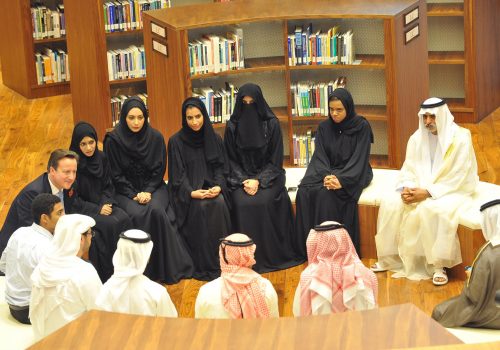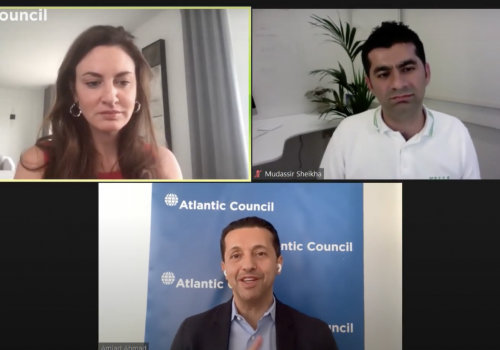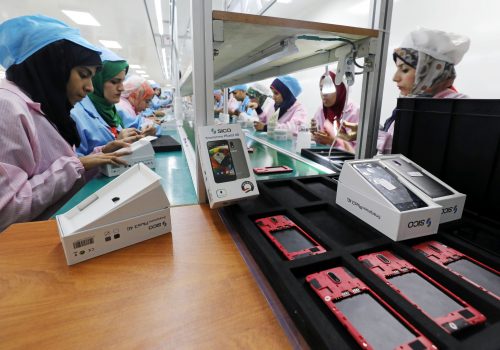Region’s economies will benefit from Gulf-Qatar deal
The dispute and blockade between Qatar and its Gulf Cooperation Council (GCC) neighbors in June 2017 have finally come to an abrupt end, bringing to close a strange four-year chapter in Gulf relations, which undoubtedly contained business and economic costs as well as serious political and social ones.
The embargo had a significant negative impact on Qatar’s economy first and foremost, but it also had indirect consequences across the Gulf, and these were ultimately in part responsible for the decision to bring the dispute to a close.
The imminent transfer of power from the Donald Trump administration to the Joe Biden administration may have played a part in making 2021 an optimal and symbolic moment to cease hostilities. Additionally, the narrowing timeline to the 2022 FIFA World Cup was most likely another element motivating the rapprochement, with the need to finish preparations and, most importantly, sell tickets.
Standoff’s impact on Qatar and its neighbors
At the start of the crisis, the expectation was that Qatar would suffer the brunt of the blockade—which it did to some extent—and that this would quickly bring Doha to the negotiating table to settle its political differences with its neighbors, chiefly Saudi Arabia and the United Arab Emirates (UAE). However, as opportunities for reconciliation in the second half of 2017 came and went, the impact of the impasse started to be felt more widely, with Qatar seemingly learning to live with the embargo, withstand the pressure, and, to some extent, thrive.
However, elsewhere in the region, sluggish growth stemming from declining oil prices was not helped by the blockade, as intra-regional trade and investment suffered, and travel and spending were also negatively affected. In the end, the Gulf could not afford another burden weighing down growth on top of other negative factors, especially those related to the coronavirus.
Qatar’s real gross domestic product (GDP) was only modestly affected by the embargo, falling from 3.1 percent in 2016 (the year prior to the dispute) to -1.5 percent in 2017, before recovering to 1.2 percent and 0.8 percent in 2018 and 2019, respectively, according to the International Monetary Fund (IMF). Of course, 2020 is likely to be much weaker due to COVID-19, with the IMF predicting a contraction of -4.5 percent, but that would be the smallest contraction among Gulf countries. Alongside the rest of the GCC, Qatar’s economy was expected to improve by 2-3 percent in 2021 prior to this month’s announcements, and will no doubt now receive a further economic boost from the lifting of the blockade as investment begins to recover and visitors return.
Still, the last few years have revealed a more challenging and nuanced picture. Qatar’s main trade routes were eliminated as a result of the blockade and fast adjustments were needed to create alternative arrangements and supply routes through the likes of Turkey and Iran. An understandable emphasis on self-sufficiency also emerged out of the crisis, with domestic agricultural production replacing regional imports from neighboring countries. Furthermore, Qatar was forced to find new destinations for its principal export—liquid natural gas (LNG), though the crucial flow of LNG to the UAE via the Dolphin pipeline was unaffected by the dispute. All of this helped the fiscal balance improve from a deficit of -2.5 percent of GDP in 2017 to a surplus of 4.9 percent of GDP in 2019 according to IMF data, with other fiscal reforms also helping to improve public finances and find efficiencies.
These steps contributed to the upgrading of Qatar’s sovereign debt by ratings agencies and generally helped to maintain the confidence of international markets during this period, with government debt continuing to be issued. The IMF released an optimistic note following meetings in December 2020 ahead of the Article IV consultation that is expected to be completed this year, highlighting “the Qatari authorities’ strong policy response to the COVID-19 pandemic and the decline in international oil prices.” The IMF sees a gradual recovery in Qatar—real GDP growth projected at 2.7 percent in 2021—and expects its ambitious structural reform agenda to underpin Qatar’s economic diversification efforts to enhance potential long-term growth.
With the political reconciliation underway, an even more favorable economic outlook for Qatar is likely, as activity ahead of the 2022 World Cup is ramped up and infrastructure projects get completed. While Saudi Arabia has understandably been the focus of most externally-oriented regional businesses and construction firms in recent years, the chances are that many will now refocus some of their attention onto Qatar as longstanding relationships get repaired.
Likely benefits for region from deal
Other parts of the GCC may stand to benefit from the healing of the 2017 dispute, as it affected them to varying degrees as well, especially as the conflict dragged on. In hindsight, the timing was far from ideal economically. It reinforced deteriorating economic conditions due to declining oil prices and oil production, putting additional pressure on GCC fiscal balances and government spending.
In the last few years, Saudi Arabia has skirted with a recession that became deeper last year due to the COVID-19 pandemic. Simultaneously, the UAE has also seen subpar annual growth of 1-2 percent, before a possible contraction of around -5.0 percent that will be seen in 2020.
Speculation is already growing about the kind of commercial peace dividend that might arise from the January truce—a natural gas deal between Qatar and Saudi Arabia is one possibility of the windfall that might be expected. Saudi imports of relatively cheap natural gas from Qatar would help meet its enormous and growing domestic energy requirements, freeing up its oil capacity for exports, which could generate billions of dollars of additional export revenue.
According to the Sovereign Wealth Fund Institute, Qatar’s sovereign wealth fund assets are worth around $300 billion. It could be deployed for regional investment, reducing the burden on Saudi Arabia in the future when it comes to assisting some of the more vulnerable GCC states.
Qatar Airways, Doha’s national airline, should be an obvious winner from the deal, since it will operate normally again after having to reroute many of its flights via Iran during the duration of the standoff. Qatar should also benefit from cheaper fuel costs. In addition, the overall economy should gain from a resumption of travel links, which should boost tourism inflows and create greater interest in its fragile real estate market from regional investors.
In the UAE’s case, a situation that was already vulnerable in 2017 became more fragile, as high-income Qatari investors stayed away from Dubai’s real estate markets and Qatari credit card spending dried up. Regional air travel also became more difficult, while international investment might also have been deterred by an impression of regional instability.
Thus, a rapprochement could not have come at a more necessary time from the GCC’s macroeconomic perspective, with intra-GCC trade likely to receive a boost and services like travel, tourism, and logistics all set to benefit. Jobs will probably be created across various sectors, especially as businesses eye the opportunities related to the 2022 World Cup and with UAE firms likely to be at the center of much of this.
Nowhere do the UAE’s and Qatar’s interests coincide more than in the delivery and success of the two major trophy events due to be hosted in the two countries in the next two years. Both Dubai’s Expo 2021 and Qatar’s FIFA World Cup 2022 are set to be major winners from the deal, as more visitors will be welcomed and entertained. Both countries are also expected to see indirect spin-off benefits from the success of the other. While politics might have played a critical role in determining the timing of the resolution of the Qatar-GCC stand-off, the region’s economies stand to be the main beneficiaries of the normalization of relations.
Tim Fox is a GCC economist and economic adviser and was formerly the head of research and chief economist at Emirates NBD.
Image: Journalists watch a screen showing the Saudi Arabia's Crown Prince Mohammed bin Salman welcoming Qatar's Emir Sheikh Tamim bin Hamad al-Thani upon his arrival to attend the Gulf Cooperation Council's (GCC) 41st Summit, at the media centre in Al-Ula, Saudi Arabia January 5, 2021. REUTERS/Ahmed Yosri


